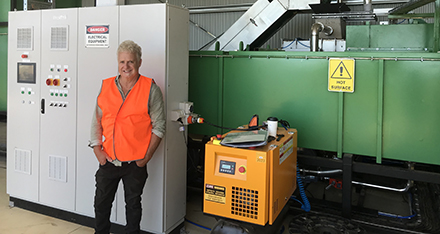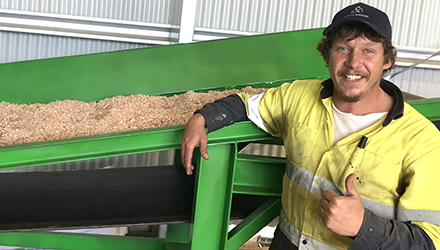Innovation is at the heart of any successful business. Radial Timber in Yarram, Victoria with a strategy already in place for its mainstream timber operation, has embarked on a new approach to using its wood waste that takes the company deeper into the heart of the sustainable, circular economy. Source: Philip Hopkins for Timberbiz
Radial has installed a pilot plant that uses pyrolysis technology; organic material, in this case wood residues, is burnt at high temperatures without oxygen to produce biochar, a stable solid that is rich in carbon and can fertilise and endure in soil for thousands of years.
“The plant can also produce heat and energy, and wood vinegar – a liquid, potentially usable in agriculture, also in cooking,” said Radial’s managing director, Chris McEvoy. The heat will play a crucial role in running the timber mill, with a potential heating source for the local community.
The $1 million pilot continuous biochar maker is the result of three years’ research and development and is a joint venture between Radial; Earth Systems, which provides the technology; and Spiegel Bioenergy, a South Gippsland battery supplier owned by John and Linda Ballis.
“We have a pure resource, most of the biochar plant around the world are working with waste, plastic waste, arboreous waste – green leaves, different species and densities; the product that comes out is not that uniform,” said Mr McEvoy.
“Our timber is all dense class, one or two timbers, all exactly the same shape. First, it should go through well, and secondly, should be a really high-value, consistent product. We’ve got plenty of resource, plenty of forestry residue. The beauty of the continuous char maker is you can put through much larger volumes. Take the biochar and put it into degraded soil’s to improve it – I love this circular economy story.”
Earth Systems, the technology provider based in Port Melbourne, was originally an environmental consulting firm founded in 1993. “For about a decade, we have been doing pyrolysis systems. We’re small but have offices all over the world for our consulting work, yet this side of the business in the last couple of years has started to take off. There is a lot more interest in biochar,” said Ricky Dent, Earth systems’ environment technology specialist who is from South Gippsland and is loving being ‘back home’ installing a plant in the region.
The company already runs a plant at Lysterfield in the Dandenong Ranges.
Mr Dent, running his hand through the feed stock – the mill’s sawdust residue – explained how the plant works.
“The residue will feed out to the first stage conveyor and go up into our shuttle drawer system. The purpose of this system is to create an air-tight seal between the outside world and the pyrolysis happening inside,” he said.
“Because pyrolysis is heat in the absence of air – it’s thermal degradation, so we must keep as much air out of the process as possible. The job of our furnace is to spread the feedstock as widely as possible to maximise surface area so we get the maximum reaction in the shortest amount of time.
“The feedstock will be then conveyed along the length of the furnace, where it will convert from wood biomass to pure carbon, which is the biochar that comes out at the end.
The gas travels in the opposite direction to the feedstock; in that way it is able to deposit its heat onto the incoming feedstock, making the whole system closed loop with very little emissions.
Ricky said in the chamber, the aim was to get the biochar to about 500 deg Celsius, with the gases jumping right up to the potentially as high as 1300 deg C.
Normally we try and keep the temperature lower, but we’re talking about generating electricity from that process, so if you want to generate electricity, the higher the temperature we get, that generally means the higher efficiency.
Mr Dent said the mill itself needs heat and electricity.
“That will be the next stage to this project, deeming what’s most economic, what works out best for everyone. We will either capture additional heat from here to assist in their process or offset their energy use at that end, or we will aim for as much electricity generation as we can, which will go into the battery storage on site and that can go out to feed the rest of the mill,” he said.
At this stage, the operation is looking at about 75 kilowatts of electrical output mainly for internal use. For external use, a bigger scale of plant, or a multiple of these plants, would be required.
“The big thing about thermal technology, it doesn’t scale in a linear fashion – it’s more exponential. Should anything go mildly wrong, the machine will shut itself down. We’ve now run long enough in Australia and we have a good relationship with the CFA; they even grant us permits to run on days of extreme fire danger. We’ve even got a permit to run on total fire ban, but we choose not to.”
Mr McEvoy will assess how the biochar plant fits in with Radial’s current operation. Having lost access to VicForests’ native hardwood timber, Radial’s plan is to use its own hardwood plantations to make the business self-sufficient in the long term.
In the interim, in the absence of larger logs, Radial will concentrate on its new peeling plant. A small log line is part of the peeler plant, which can peel a small log down into veneer sheets, which are dried, glued and pressed. This engineered timber can theoretically be used to make mass panels
“We could not run the peeling plant we want to run because of the requirements to heat the logs before they are peeled. Once peeled, you must dry the veneers through this big dryer; doing that on gas and electricity, you would never afford it.
“We can’t put a peeling plant in without a bio-plant. If we put the full LVL plant in, we need a lot of heat.” That may require the use of technology called ROC – a Rakin cycle engine that produces electricity off waste heat from the pyrolysis plant.
“What’s really exciting – solar is only good in summer or daylight; no sun – no solar. The idea of the biochar plant and this ROC – I believe no one in Australia is doing this – is to have a solar system and a renewable recharge system that is not solar. The idea there is – use the free energy from the sun, use the battery and charge the batteries at night with the biochar plant while you are producing biochar, which is closing that loop. That’s how it’s connected.”
Mr McEvoy said he was more interested in the heat and energy first – the project was ‘stacking up’ on energy – but then he also got excited by the bioproducts. “Having a multi-faceted business plan, it’s great; it potentially covers any risk. The fact is you are getting all those products and using a waste resource,” he said.
Radial, having worked on the project for three years, aims to get the pilot plant up and running and “see where we go from here”. “We will test the market with forestry, including our own plantations, agribusinesses, nurseries, even some value-added like graphene (which is used for batteries). When you have product, you can go out into the market with bulk examples,” said Mr McEvoy.
“We are going to bring together potentially interested parties in the bioproducts, get them involved in the journey of the pilot plant. LandCare Australia is very keen, and some of the agribusinesses are definitely keen. They can set up their own R and D trials, they can potentially become our sales agent.”
Mr McEvoy said wood vinegar, a liquid product available from the pyrolysis plant, was potentially useable in agriculture. “It’s an extract from pyrolysis oils used as an organic herbicide replacement for Roundup. It’s also used in cooking. This is the new bioeconomy – refining wood fibre products into other products,” he said.
While that’s happening, Mr McEvoy said Radial would also test to see what sort of heat and energy they could get, how much product and “iron out the bugs”. ARENA (the Australian Renewable Energy Agency), having funded batteries and solar, was looking at new renewables. “They want some stuff that has not taken off and could be commercial and could have scale. We will bring them on that journey. They’ve got funding. We don’t need funding tomorrow, but that would be great in the future,” he said.







